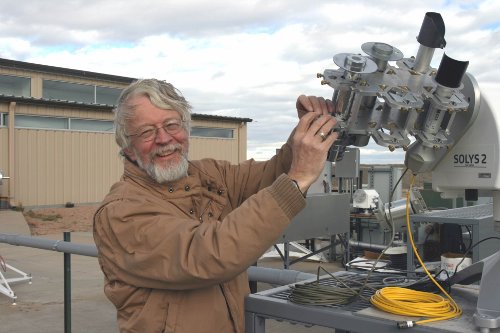Dr. Ellsworth G. Dutton
1949-2012

Photo courtesy of Steve Wilcox, NREL
ESRL atmospheric scientist Ellsworth Dutton passed away on 11 October, 2012. His loss was a blow not only to family and friends, but also to the greater atmospheric sciences community. He was widely respected for his careful study of the surface radiation budget of the Earth.
Ells grew up in rural Iowa and graduated from high school with 23 others. He received his B.S. in aerospace engineering in 1971 from Iowa State University. The following year he decided that his true passion was meteorology and returned to Iowa State to begin a Masters degree program. He later transferred to Florida State University where he obtained his M.S. in 1975. He was subsequently hired by a private firm in Boulder, Colorado as a field team leader to evaluate the effects of meteorology on the air sampling they were doing to find anomalous sources of radon (uranium prospecting).
In 1978 he was hired by the Cooperative Institute for Research in Environmental Sciences (CIRES) at the University of Colorado to run its fledgling fluorocarbon-monitoring program. In 1980 he was hired by NOAA to take charge of the surface radiation monitoring program at their four baseline sites at the South Pole; Barrow, Alaska; American Samoa; and Mauna Loa, Hawaii. Since obtaining his Ph.D. in 1995 from the Department of Atmospheric Science at Colorado State University he has served as the Chief of the Radiation Group of the Global Monitoring Division (GMD) of the Earth System Research Laboratory, formerly the Climate Monitoring and Diagnostics Laboratory
His Ph.D. thesis was on climate forcing associated with the last two major volcanic eruptions, El Chichon and Mt. Pinatubo. He compared observations and calculations of the radiative forcing of aerosols that formed in the stratosphere after those eruptions. He was also quite proud of his role as custodian of the Mauna Loa Observatory ‘apparent’ transmission record that began in the late 1950’s and was last updated by Ells for the BAMS State of the Climate report in 2011. The radiation measurement and research communities have greatly benefitted from his unwavering efforts to improve the quality and reduce the uncertainty of solar and infrared surface radiation measurements. One of the last topics he was working on was the periodic dimming and brightening of surface solar radiation. He and others primarily used GMD station records to examine the brightening that has occurred over the last 15 years using this carefully calibrated and well-maintained measurement set.
In addition to his NOAA responsibilities, Ells accepted the position of International Project Manager for the World Climate Research Program’s Baseline Surface Radiation Network (BSRN) in 1992, continuing in this role until his death. The BSRN is widely regarded as the premier surface radiation budget network for the world and Ells’ group at NOAA operates 11 of its 50 member stations. These high quality data are used for satellite and model validation and are also used to accurately track subtle changes and long-term trends in the surface radiation budget.
His scientific leadership, dry wit, and calm presence will be missed. Ells is survived by his wife Vicki Schroeder and his many friends and colleagues in Boulder and around the world.
